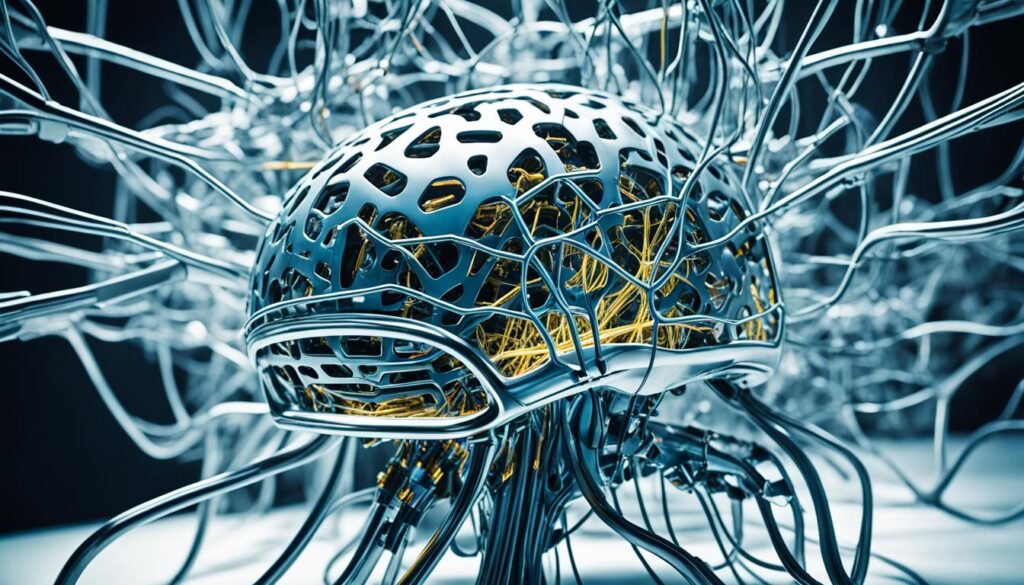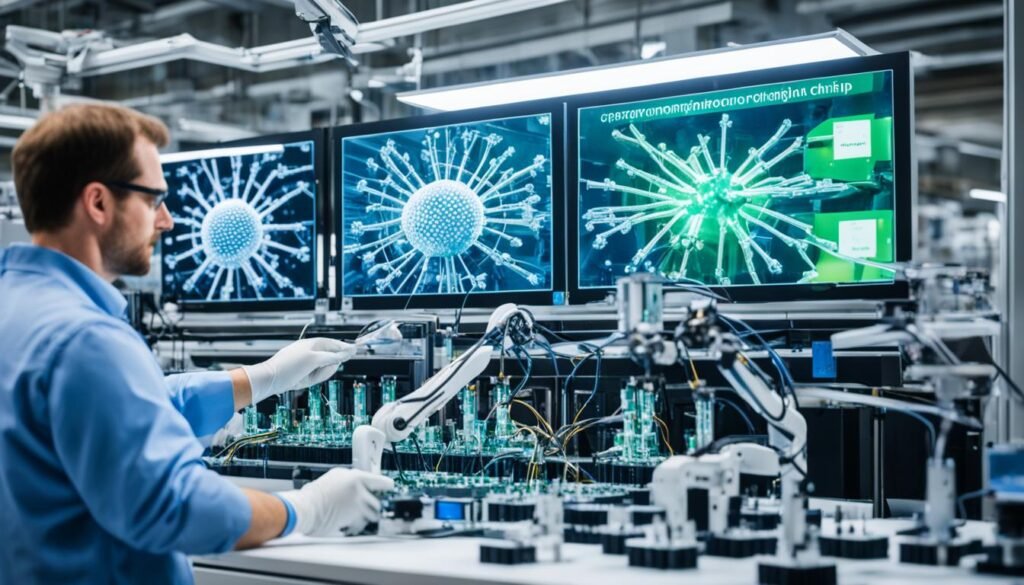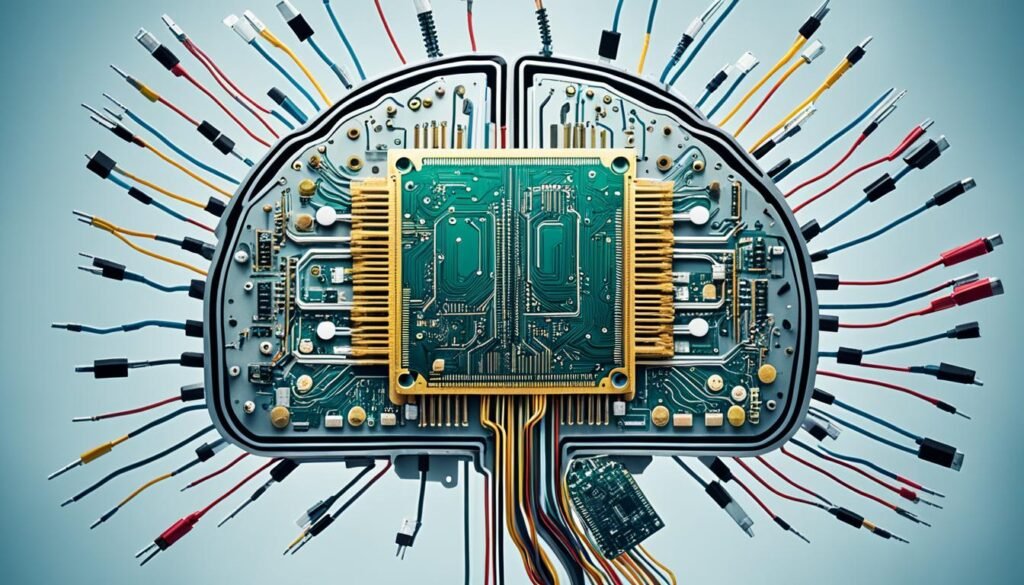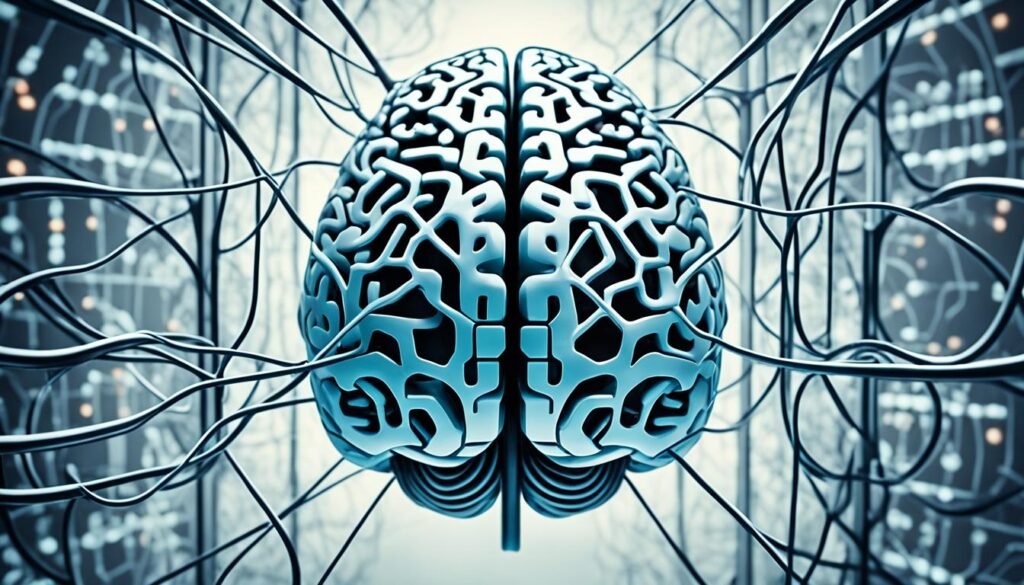Over 3,000 papers have been reviewed in the 35-year history of neuromorphic computing, as shown by Schuman et al. (2017)1. This shows the huge potential and growing interest in making AI systems that work like the human brain. By studying how our brains work, neuromorphic computing aims to change how we make AI. This will lead to more efficient, adaptable, and smart machines.
“Neuromorphic” was coined by Carver Mead at the California Institute of Technology in the late 1980s2. It means devices and systems that act like our brains. This new way of making computers could lead to huge energy savings and smarter machines. For example, a digital brain simulation uses about 7.9 MW, but our real brain works on just 20 W2. By using neuromorphic computing, we can make AI systems as efficient as our brains.
Recently, neuromorphic computing has made big strides. Researchers are looking at different ways to copy the brain’s complex networks. Frenkel et al. (2021a) sorted neuromorphic systems into two types: top-down and bottom-up1. This helps researchers understand and compare different methods, speeding up the creation of brain-like AI.
Zhang et al. (2020) came up with important metrics for comparing neuromorphic systems1. These metrics include how much computing power, energy use, accuracy, and learning ability a system has. These benchmarks help us see how well neuromorphic architectures work and guide us in making better ones. By using these metrics, we can pick the best neuromorphic computing methods and improve them for real use.
Key Takeaways
- Neuromorphic computing uses the brain to make AI systems that are efficient and adaptable.
- There has been a lot of progress, with over 3,000 papers reviewed in 35 years.
- Systems can be sorted into top-down and bottom-up types, making it easier to analyze and compare them.
- Metrics like compute density, energy efficiency, accuracy, and learning ability help us judge neuromorphic systems.
- Neuromorphic computing could help bridge the energy gap between AI and the human brain, leading to more efficient AI.
Introduction to Neuromorphic Computing
Neuromorphic computing is a new way to make artificial intelligence that looks at how the human brain works. It tries to make AI systems that work like the brain, with its many neurons and connections. This new field could change how we use artificial intelligence and what it can do.
Definition and Key Concepts
Neuromorphic computing is about making special computers that work like the brain’s neurons and connections. These computers mix memory and processing into one part, just like the brain does. This helps them work better together and process information fast3.
This way of building computers tries to fix problems with old computer designs. Old computers move data around a lot, which uses a lot of energy. They also have trouble mixing short and long-term memory3.
At the heart of neuromorphic computing are spiking neural networks (SNNs). These networks use electrical signals like the brain does. They use a model called Leaky Integrate and Fire (LIF) to work like real neurons4. This makes them great for small devices that need to work for a long time without using a lot of power4.
Inspiration from Biological Neural Networks
The human brain is amazing, with 86 billion neurons and 150 trillion connections, all using just 20 watts of power4. This efficiency and complexity inspire neuromorphic computing. Researchers want to make AI that learns and thinks like the brain.
Neurons in the brain talk to each other with electrical signals and connections called synapses3. These connections can change, which helps the brain learn and remember things. Researchers are looking at different materials to make these connections in computers3.
The human brain’s incredible efficiency and complexity serve as the primary inspiration for neuromorphic computing, driving researchers to create AI systems that exhibit similar levels of adaptability, learning, and cognitive capabilities.
By looking at how the brain works, neuromorphic computing wants to change artificial intelligence. This new approach could make AI more efficient, adaptable, and smart.
Principles of Neuromorphic Computing

Neuromorphic computing is a new way to make computers work like our brains. It uses the brain’s structure and how it works to make systems better, more adaptable, and smarter. This approach focuses on spiking neural networks, how connections change, and processing information in parallel.
Spiking Neural Networks
Spiking neural networks are key in neuromorphic computing. They work like real neurons, using electrical impulses to send and process information5. These networks let systems work efficiently and think like our brains5.
Synaptic Plasticity and Learning
Synaptic plasticity is crucial in neuromorphic computing. It’s how connections between neurons change based on activity5. This lets systems learn and adapt, making them better over time5.
Parallel and Distributed Processing
Neuromorphic systems work like our brains, processing information at the same time6. This means they can do many tasks together, which is faster than old computers5.
They also process information across many neurons and connections7. This way, they keep working even if some parts fail. This makes them efficient and powerful65.
Spiking networks, changing connections, and parallel processing are the basics of neuromorphic computing. These ideas could change how we use artificial intelligence, robotics, and study the brain5. As we keep improving this technology, we’ll see big changes in how we interact with machines5.
Advantages of Neuromorphic Computing over Traditional AI
Neuromorphic computing has many benefits over traditional AI. It closely mimics real neurons, which could lead to faster and more energy-efficient computing8. Unlike traditional computers, which have separate parts for processing and memory, neuromorphic systems can process data faster9.
Neuromorphic computing shines in parallel and distributed processing, similar to the brain’s neocortex8. This lets it handle complex tasks like sensory perception and language processing well. It’s great at recognizing patterns, which is crucial in cybersecurity and health monitoring8.
These systems are also super adaptable. They learn and change in real-time, improving over time8. This, along with processing data in one place, makes them faster than traditional computers9.
Efficiency is another big plus. Neuromorphic systems can do many tasks at once, making them faster and using less energy8. They use much less power than older computer designs9.
Stanford University professor Kwabena Boahen says AI computations are getting bigger every few months. Experts think neuromorphic computing could help overcome Moore’s Law challenges8.
But, there are hurdles in developing neuromorphic computing. There’s no standard way to measure performance, and it’s hard to learn and use the tech. It’s also not as precise as some neural networks8. Yet, with more research, it could change AI and make it more efficient and adaptable.
Neuromorphic Hardware Architectures

Neuromorphic computing has made big strides in recent years. We’ve seen the creation of special hardware that copies the brain’s neural structure and how it works10. This field has seen huge leaps forward thanks to a mix of different sciences working together10. This mix includes designing hardware that gets more complex, from simple devices to whole systems10.
Neuromorphic Chips and Processors
Neuromorphic chips and processors aim to mimic the human brain’s neural networks11. Early on, in the 2000s, chips like IBM’s TrueNorth and the SpiNNaker project started to speed up neural network simulations11. These computers use many neurons and synapses and work in parallel, unlike traditional computers12. They also don’t have the von Neumann bottleneck and can grow by adding more chips12. Big neuromorphic computers like SpiNNaker, BrainScaleS, Tianjic, TrueNorth, Loihi, and BrainScales-2 have been built12.
Memristors and Emerging Technologies
Memristors are key for neuromorphic systems because their resistance changes based on their history11. They can act as digital memory, changeable artificial synapses, and even mimic biological neurons, all while using little energy. Neuromorphic hardware uses memristors to copy how synapses and neurons talk to each other11. Researchers are exploring new materials like phase-change materials and ferroelectrics for these systems, besides memristors12. This variety in devices and materials lets us tailor them for different uses12.
Neuromorphic hardware is efficient because it only works when it needs to and can be random in its calculations12. These systems use much less power than old systems, making them great for saving energy12. They’re perfect for tasks that need to be done quickly, adapting, and learning over time11. Techniques like reservoir computing and deep learning are being used in these systems for things like robotics and finding objects in real-time10.
Applications of Neuromorphic Computing
Neuromorphic computing is inspired by the human brain. It has the power to change many industries and areas. This new AI approach is great for saving energy, handling tasks quickly, and adapting easily. It’s perfect for many uses1314.
As it gets better, neuromorphic computing is changing how we use robotics, autonomous systems, and more. It’s making a big mark in areas like sensory processing, pattern recognition, and decision making too.
Robotics and Autonomous Systems
In robotics and autonomous systems, neuromorphic computing is a big deal. It helps robots and self-driving cars understand and react to their world fast. This lets them move through tough places, change plans when needed, and work well with people13.
Self-driving cars, for example, could use neuromorphic computing to save energy and sense their surroundings better. This would help them work better in different places13.
Sensory Processing and Pattern Recognition
Neuromorphic computing is great at handling sensory info and recognizing patterns. Neuromorphic vision sensors work like the human eye, reacting to what’s around them and making images on the fly13. They don’t have the usual problems of blurry images or slow responses13.
This makes them perfect for tasks like recognizing images and speech, tracking objects, and smart surveillance14.
Cognitive Computing and Decision Making
Neuromorphic computing is also key in cognitive computing and making decisions. It works like the brain, handling lots of data and making quick choices1314. In healthcare, it could help spot diseases early, suggest treatments, and create brain-computer interfaces13.
This tech is still new but very promising for many fields13.
| Application Domain | Key Benefits of Neuromorphic Computing |
|---|---|
| Robotics and Autonomous Systems | Enhanced perception, decision-making, and adaptability |
| Sensory Processing and Pattern Recognition | Real-time processing, event-based sensing, and improved accuracy |
| Cognitive Computing and Decision Making | Efficient data analysis, pattern detection, and real-time decision making |
As neuromorphic computing gets better, its impact will grow in many areas14. It’s great for saving energy, working fast, and handling tasks in real-time. This makes it perfect for things like self-driving cars, smart devices, and more14.
The unique traits of neuromorphic computing make it exciting for innovators, even if it’s still new13.
In conclusion, neuromorphic computing is changing many fields, from robotics to decision making. As it keeps getting better, it will play a big part in the future of AI and society.
Challenges and Limitations of Neuromorphic Computing

Neuromorphic computing is a big step forward for artificial intelligence and brain-like thinking. Yet, it faces many hurdles to reach its full potential. These hurdles include scalability, integration with current systems, algorithm development, and optimization for specific tasks.
Scaling up neuromorphic computing while keeping it efficient and fast is a big challenge. For example, IBM’s TrueNorth chip has 4096 cores and over 250 million synapses15. But it’s still much smaller than the human brain, which has billions of neurons and trillions of synapses15. Researchers are working hard to make neuromorphic tech faster, smaller, and more energy-efficient for use in mobile devices and standalone systems16.
Scalability and Integration with Existing Systems
Getting neuromorphic systems to work with current AI and computers is tough. These systems use Spiking Neural Networks (SNN), which are different from traditional networks15. To make them work together, new solutions and standards are needed. Also, making sure different systems use the same neural weights is hard16.
Algorithm Development and Optimization
Creating algorithms that use neuromorphic hardware’s strengths is key. This means making new algorithms that take advantage of its parallel processing. Techniques like those in Google’s Tensor Processing Unit (TPU), which boost neural network power efficiency by 95 percent16, need to be applied to neuromorphic computing.
To overcome these hurdles, we need a team effort from neuroscience, computer science, and engineering. Researchers are looking into new tech like memristors for more efficient and less power-hungry neurons16. Working together between schools and companies is crucial to tackle the big challenges, improve algorithms, and set standards.
The potential for neuromorphic computing to solve tough AI problems is huge. It could start a new industry with its own version of Moore’s Law, focusing on smart and intelligent tasks16.
As we keep researching and solving these problems, neuromorphic computing could change AI for the better. It could lead to more efficient, brain-like systems that can handle complex tasks. The path ahead is tough, but the benefits could be huge.
Current Research and Development Efforts
The field of neuromorphic computing started in the 1980s with Carver Mead’s groundbreaking work17. Now, it’s seeing a big push forward with efforts from top schools like Purdue University, University of California San Diego (UCSD), and École Supérieure de Physique et de Chimie Industrielles (ESPCI) in Paris18. These teams are making big strides in creating brain-like AI solutions.
Recent studies in Advanced Electronic Materials show how vanadium oxides could help make artificial neurons and synapses. This could lead to processors that use less energy, work better, and learn on their own18. The discovery of how vanadium oxides change with temperature could be a game-changer for neuromorphic devices18.
Big names like Intel, IBM, and Qualcomm are also diving deep into neuromorphic tech. Intel’s Loihi chip, now in its second version, is being used for things like improving traffic flow and controlling robots17. IBM’s TrueNorth chip is great for spotting patterns in health data and handling real-time sensor info17. Qualcomm is looking into combining deep learning with neuromorphic tech for better efficiency and power use17.
Even though making a brain-like computer is tough, experts think the future will mix different tech types, including neuromorphic, photonic, and quantum computing17. Making standards and open-source tools is key to moving neuromorphic computing forward.
The neuromorphic chip market is expected to hit about USD 5.83 billion by 2029, growing at a 104.70% annual rate from 2024 to 202919. But, neuromorphic computing still faces hurdles like getting less funding than digital AI or quantum tech, proving it’s better than traditional methods, and figuring out how to measure its performance19.
Top research spots like Caltech, MIT, Max Planck Institute for Neurobiology, and Stanford University17 are leading the charge in neuromorphic computing. They’re working together to push the field forward by:
- Creating more powerful neuromorphic hardware
- Improving algorithms for better learning and processing
- Looking into new uses in robotics, computer vision, and personalized interfaces
As research goes on, neuromorphic computing will likely get more efficient and work well with other smart tech17. This could change how we automate things and make smart systems in many areas17. The teamwork between schools and companies, along with standardization and open-source tools, will help unlock the full potential of neuromorphic computing.
Collaborative Initiatives and Partnerships

Neuromorphic computing is seeing a big increase in partnerships. These bring together experts from schools and companies to work on this new tech. These partnerships are key for using everyone’s skills and resources to make brain-like computers better.
Academic and Industry Collaborations
Now, schools and big companies are working together to make neuromorphic computing better. Researchers at top universities are teaming up with companies like IBM, Intel, and NVIDIA. They’re making new kinds of brain-inspired computers.
For example, IBM made a chip called TrueNorth with a million neurons and 256 million synapses. This shows how schools and companies can work together well20. Intel also made a system called Loihi with help from schools. It uses much less energy than old computers for some tasks20.
These partnerships are not just about making chips. They also cover AI, neuromorphic hardware, and tiny electronics. This shows a wide range of research in neuromorphic computing20. A model called DEXAT from IIT-Delhi makes brain cells work better, making them faster and using less energy20. These partnerships help speed up the use of neuromorphic systems in real life.
Standardization and Open-Source Frameworks
Standardizing things and using open-source helps everyone work together better in neuromorphic computing. There are efforts to make standards and interfaces that let different systems talk to each other easily. This makes it easier for everyone to use and improve neuromorphic tech.
Open-source tools and frameworks are getting popular too. They let people share ideas and work together faster. These tools make it easier to try out new things, test them, and make new algorithms. Projects like the Human Brain Project and Nengo are great examples of how open-source helps everyone work together and move things forward in neuromorphic computing.
| Collaboration Type | Key Initiatives | Impact |
|---|---|---|
| Academic-Industry Partnerships | IBM TrueNorth, Intel Loihi, DEXAT model | Accelerated development of neuromorphic hardware and algorithms |
| Standardization Efforts | Establishment of common protocols and interfaces | Improved interoperability and integration of neuromorphic systems |
| Open-Source Frameworks | Human Brain Project, SpiNNaker, Nengo | Collaborative research, knowledge sharing, and rapid prototyping |
Big companies are also working together to advance neuromorphic computing. For example, Dynex and Etica’s research community are working together. Dynex gave 100,000 credits to support Etica’s research21. Dynex’s chip, using the DynexSolve algorithm, is very powerful and has a big market share21. This helps researchers use advanced neuromorphic computing tools to make new algorithms and architectures.
As more people work together, neuromorphic computing is set for big advances. By combining skills and resources from schools, companies, and open-source groups, we’re getting closer to making brain-like computers a reality. This will start a new era of smart and efficient computing.
Future Directions and Potential Impact
Researchers are pushing the limits of AI by improving neuromorphic algorithms and architectures. They aim to make computers work like our brains, using principles like spiking dynamics and spike-timing-dependent plasticity (STDP)22. New hardware like chips and systems-on-chip (SoCs) show how far we’ve come22.
Advancements in Neuromorphic Algorithms and Architectures
Scientists are finding new ways to make neuromorphic systems better at learning and adapting. They aim to use less energy too. The human brain uses about 20 watts and has billions of neurons, each connecting to many others23. Chips like IBM’s TrueNorth mimic a million human neurons and 256 million synapses23. Projects like SpiNNaker aim to model the human brain in real time23.
Integration with Other Emerging Technologies
Combining neuromorphic computing with other new technologies opens up new possibilities. These computers can do complex tasks fast and use less power than old systems24. They’re great for space missions because they’re small, use less power, and can handle radiation well24.
Researchers are working on hybrid systems that blend neuroscience and computer science22. Mixing neuromorphic computing with quantum computing and other tech could lead to huge leaps in AI22.
Neuromorphic tech could change many areas, from smartphones to healthcare, with big impacts23.
As it grows, neuromorphic computing could change many fields, from robotics to healthcare23. IBM’s Dharmendra Modha sees these chips as just the start, showing the huge potential ahead23.
| Application Domain | Potential Impact |
|---|---|
| Space Exploration | Efficient AI for object recognition, detecting changes, controlling robots, and making decisions24 |
| Robotics | Better thinking, adapting, and saving energy |
| Healthcare | Smart medical devices, tailored treatments, and better diagnostics |
| Intelligent Sensors | Better sensing, recognizing patterns, and analyzing data |
Ethical Considerations and Societal Implications

Neuromorphic computing is moving fast, and we must think about its ethical sides. We’re seeing more patents focused on making AI responsible25. This shows a big jump in patents on using AI ethically and making AI make fair decisions25.
Privacy is a big worry with neuromorphic tech. As these devices get better, like reading brain signals26, keeping our data safe is key. Also, teaching one brain to another or adding fake memories in animals26 brings up big ethical questions.
Being fair and clear is crucial for neuromorphic tech. More patents are coming in on making AI fair and spotting bias25. Researchers aim to fix biases and treat everyone equally. They’re also working on AI that explains its choices25.
Neuromorphic computing is moving fast, so we need to act fast on ethics. Working together is key to making sure this tech is used right.
This tech could change many areas like healthcare and cars25. With more patents on safe AI use25, we see the need to think about its effects. For instance, using AI to help with pain26 is good, but we must think about our privacy.
| Ethical Consideration | Societal Implication |
|---|---|
| Privacy and data security | Potential misuse of personal data |
| Fairness and bias detection | Equal treatment and non-discrimination |
| Explainable AI | Transparency and accountability |
| Responsible AI practices | Safe and ethical deployment across sectors |
As neuromorphic computing grows, we need to keep talking and working together. Focusing on responsible AI lets us use this tech well. It helps us avoid risks and make sure it helps everyone.
Case Studies and Real-World Examples

Neuromorphic computing has made big strides in recent years. It has shown its power in advanced AI and modeling the brain. These examples show how it saves energy, works fast, and adapts well.
Successful Implementations of Neuromorphic Systems
Intel’s Loihi research chip is a big name in neuromorphic computing. The Loihi 2 chip is even better, up to 10 times faster. It uses less power and can do more tasks, thanks to new improvements27.
IBM has also been working on neuromorphic chips since 2014 with its TrueNorth chip28. Companies like Qualcomm and Nvidia are also getting into it28. BrainChip made the Akida processor, which does tasks like recognizing objects and faces fast and uses less power28.
| Company | Neuromorphic Chip | Key Features |
|---|---|---|
| Intel | Loihi 2 | 10x performance improvement, 2x-160x resource density optimization, event-based messaging, enhanced learning capabilities |
| IBM | TrueNorth | In development since 2014, aimed at achieving higher efficiency through neuromorphic computing |
| BrainChip | Akida | Supports CNN, DNN, ViT, and SNNs; requires significantly less power than traditional systems |
Lessons Learned and Best Practices
These successes have taught us a lot about making neuromorphic systems work well. One key point is the need to connect with regular sensors and systems smoothly. This has been a challenge but is key for neuromorphic computing to grow27.
Improving how many tasks a neuromorphic chip can do with the same resources is also important. Intel Labs has made big strides in this area. Their Loihi chip works fast, adapts well, and uses very little power, unlike traditional computers27.
As more people use neuromorphic computing, sharing knowledge and working together is crucial. Gartner sees it as a key technology for the future28. These lessons and best practices will help shape the future of neuromorphic computing and AI.
Neuromorphic Computing: The Next Frontier in AI

We’re on the edge of a new era in artificial intelligence, and neuromorphic computing is leading the way. It’s inspired by the human brain and could change how we think about AI. This new approach could make AI systems more efficient, adaptable, and smart29.
Neuromorphic computing mimics the brain’s way of processing information. It uses less power and can learn and make decisions on its own29. This could lead to more efficient and smart AI solutions29.
This technology has many uses, from robots to healthcare. It lets systems work on their own, making new things possible29. With ongoing research, we might see AI that fits into our daily lives better, making decisions for us29.
The market for neuromorphic computing is growing fast. It was worth USD 31.2 million in 2021 and could reach USD 8,275.9 million by 203030. Europe is expected to see the biggest growth30.
| Aspect | Traditional Computing | Neuromorphic Computing |
|---|---|---|
| Architecture | Sequential, centralized | Parallel, distributed |
| Processing | Clock-driven, synchronous | Event-driven, asynchronous |
| Energy Efficiency | High power consumption | Low power consumption |
| Scalability | Limited by Moore’s Law | Highly scalable |
| Adaptability | Predefined, rigid | Flexible, learning-based |
Neuromorphic computing is changing the game in tech and AI29. It could help companies and experts in AI do more with less time29. It also combines well with other new tech like IoT and edge computing, making it even more powerful.
Neuromorphic computing is a big change in AI. It could totally change how we use smart systems and unlock new brain-like abilities.
As we move forward with neuromorphic AI, we need to think about the challenges and ethics. Working together, we can make sure this tech is used right and helps society.
The future of computing is all about combining neuroscience and AI. Neuromorphic computing is leading this change. By using brain ideas, we can start a new era of AI innovation. This will make AI a bigger part of our lives, helping us make better decisions and explore new AI possibilities.
Conclusion
As we conclude our journey into neuromorphic computing, it’s clear this brain-inspired AI has huge potential. It could change the future of artificial intelligence. By copying the human brain, these systems can do complex tasks better and faster31. The future looks bright, with a market value of $1.78 billion by 2025, showing its fast growth and big investments32.
New hardware like neuromorphic chips helps computers work like our brains3233. This means computers can do tasks like recognizing images and understanding speech better31. But, we need more work and teamwork to fully use this technology31.
We must tackle the challenges and ethical issues of neuromorphic computing. More research and ethical rules are needed for responsible use31. With neuromorphic computing, we can solve big problems and make technology better. It could make AI work better with our brains, opening new doors for innovation and progress.
FAQ
What is neuromorphic computing?
Neuromorphic computing is a new way to make artificial intelligence (AI) work like our brains. It uses the brain’s structure and how it works to make AI better. This makes AI systems more efficient and able to handle complex tasks like we do.
How does neuromorphic computing differ from traditional AI?
Unlike traditional AI, neuromorphic computing uses special hardware to copy the brain’s neural networks. This means AI systems can learn and adapt, making them more efficient and capable. Traditional AI uses old computing methods.
What are spiking neural networks?
Spiking neural networks are a big part of neuromorphic computing. They work by sending information through electrical impulses, just like our brains do. They can learn and change over time, which helps them adapt and improve.
What are the advantages of neuromorphic computing?
Neuromorphic computing lets computers work like our brains, handling many tasks at once. This makes them more efficient, uses less power, and helps them understand complex information better. It’s great for real-time tasks.
What are neuromorphic chips and processors?
Neuromorphic chips and processors are special kinds of hardware. They’re made to work like the brain’s neural networks. They use parallel processing and other brain-like features to make AI systems better.
What are the potential applications of neuromorphic computing?
Neuromorphic computing could change many areas, like robotics and how we understand sensory data. It could improve how we make decisions and interact with complex situations. It might even help detect diseases early and create new ways to talk to computers.
What are the challenges in neuromorphic computing?
There are a few hurdles in neuromorphic computing. For example, making these systems efficient and scalable is hard. Also, creating algorithms that use neuromorphic systems fully is tough. And, understanding how the brain works is still a challenge.
What is the future outlook for neuromorphic computing?
The future looks bright for neuromorphic computing. With new advancements, we can expect AI to get better at handling complex tasks. As research goes on, neuromorphic computing could change how we use AI in many areas.
What are the ethical considerations in neuromorphic computing?
As neuromorphic computing grows, we need to think about its ethical side. We must consider privacy, security, fairness, and avoiding bias. We also need to think about how it might affect jobs, education, and how we interact with machines.
What are some real-world examples of neuromorphic computing?
There are real examples of neuromorphic computing out there. For instance, it’s used in self-driving cars, edge computing, and energy-saving AI in IoT devices. These examples show how neuromorphic computing can solve tough problems and make things more efficient.
